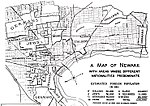Penn Plaza East

The Penn Plaza East complex takes its name for its location near Penn Station in Newark, New Jersey. Fronting Raymond Boulevard on the banks of the Passaic River, the two office buildings were constructed during a period in the late 1980s and early 1990s when they and numerous postmodern skyscrapers were built near the station and Gateway Center. While others went up between the station and traditional Downtown Newark, Penn Plaza East is on the Ironbound, or east, side of the major transportation hub. As of 2010, the buildings are occupied by the corporate headquarters of New Jersey Transit, JOC Group, and Horizon Blue Cross Blue Shield of New Jersey, which owns their building.Originally developed and owned by Hartz Mountain Industries One building was later bought by Horizon Blue Cross Blue Shield of New Jersey.The two towers sit above a four-story parking facility and lobby that joins them. An additional parking area in the shadow of the Dock Bridge will be developed as part Newark Riverfront Park a promenade along the banks of the river.
Excerpt from the Wikipedia article Penn Plaza East (License: CC BY-SA 3.0, Authors, Images).Penn Plaza East
Penn Station Buses, Newark
Geographical coordinates (GPS) Address Phone number Website Nearby Places Show on map
Geographical coordinates (GPS)
| Latitude | Longitude |
|---|---|
| N 40.734722222222 ° | E -74.164166666667 ° |
Address
McDonald's
Penn Station Buses
07102 Newark
New Jersey, United States
Open on Google Maps








